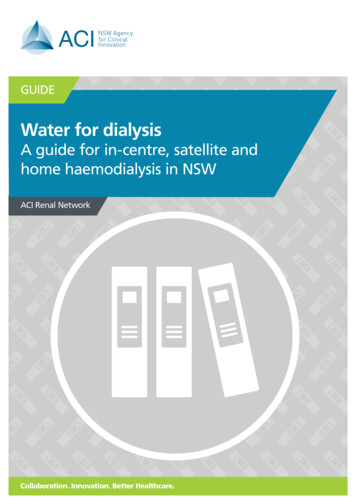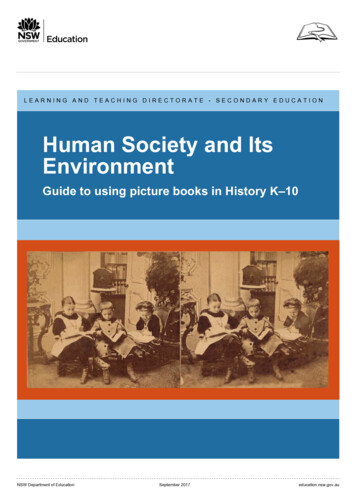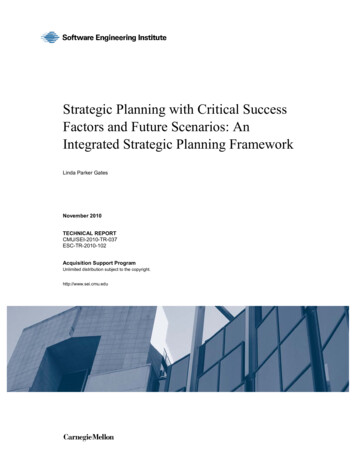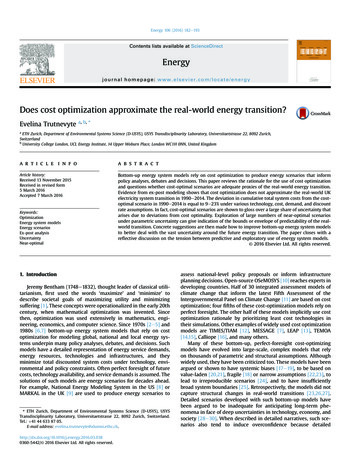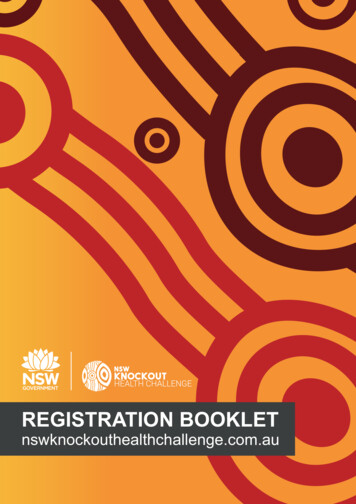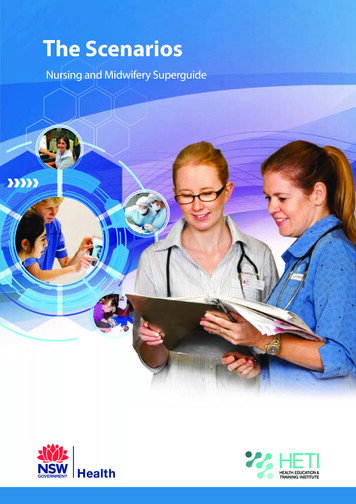
Transcription
The ScenariosNursing and Midwifery Superguide
NURSING AND MIDWIFERY SUPERGUIDE SCENARIOSPOINT OF CARE - Scenario 1(Clinical teaching of a procedure at the bedside)Karen is the Clinical Nurse Educator of a high dependency unit. She has been involved ineducating Rob, a new member of staff, and helping him make the transition back into theworkplace. Rob has previous experience working in high dependency, but has spent thelast four years away from nursing.scenario 1During a morning shift, Rob is required to change the central line dressings on a numberof his patients. He approaches Jo, a senior Registered Nurse, and asks if she will providesome clinical teaching. Jo agrees, but tells Rob “it will have to be quick, I’m very busy.”She instructs Rob to wait at the bedside while she assembles the equipment. She returnsand begins washing her hands and setting up the dressing trolley, ignoring both Roband the patient. She begins the procedure with no word of explanation to the patient.The curtains are open and the patient’s chest is partially exposed to access the centralline site. The patient looks confused and upset. Jo speaks directly to Rob, ignoring thepatient. “Now watch, I’ll show you how to do this once, and the rest you should be ableto do on you own.” She carries out the procedure, occasionally describing her actions,but mostly using medical terminology that the patient cannot understand. Rob attemptsto ask questions, but receives only brief responses. He gets the sense that Jo does notappreciate being interrupted. When Jo is finished, she looks to Rob and asks “Are we‘all good’ now? If you have any problems, talk to one of the other girls, I’m really busy.”She walks away, leaving Rob and the patient looking slightly bewildered.Karen is passing by the bedspace soon after, and finds Rob looking anxious. She observesthat Rob is preparing a trolley for a procedure. She asks Rob if he would like any help.Rob explains the situation. In the interests of patient safety, it is unit policy for new staffto complete a learning package and formal assessment prior to being able to performcentral line dressings unsupervised. Karen decides to use this opportunity to reviewthe learning package and practice some on the spot clinical teaching at the bedsidewith Rob.Karen asks Rob if he has performed central line dressings in the past, and if so, how it wasdone. Rob states that he has, but that it was “a long time ago.” He is keen to refresh hisknowledge and receive some education about the procedure and rationale. Rob statesthat he has recently reviewed the literature in the learning package related to central linedressings in order to familiarise himself with the unit’s practice.Rob’s learning goal is to be able to safely demonstrate correct procedure for changing acentral line dressing. Karen discusses her expectations for the morning’s clinical teachingand outlines the plan of action. Karen will allow Rob to observe as she performs a centralline dressing, providing him with a rationale for each step. She encourages Rob to askquestions throughout the procedure. She will then supervise as Rob performs a dressingchange, provided she feels he has understood the clinical teaching and is safe to carryout the task. Karen will assess Rob using the assessment tool in the learning package.PAGE 1
NURSING AND MIDWIFERY SUPERGUIDE SCENARIOSThe results of the assessment will be documented and conveyed to the Nursing UnitManager (NUM). Guided questioning will be used throughout the process, to assess Rob’sunderstanding and critical thinking skills. Karen will give feedback on Rob’s performanceas he carries out the task, and at the conclusion of the learning session.Karen supervises as Rob assembles the necessary equipment. They approach the bedsideof Mrs M. Karen introduces herself and obtains her consent for the procedure and forthe clinical teaching. Karen’s priority is to ensure that patient safety, comfort, dignity andprivacy are maintained throughout the procedure/teaching. She assures Mrs M that allaspects of her care will remain confidential.scenario 1Karen washes her hands and performs the dressing change on Mrs M, ensuring allcommunication involved in the process is explained so that the patient understands. Roblistens and asks questions to clarify information and expand his current knowledge.Karen then asks Rob to discuss the steps of the task, providing a rationale at various stagesof the process. Karen uses guided questioning to encourage independent thinking andproblem solving. For example, ‘What approach are you taking here and why? What are thepossible complications? How would you recognise/prevent/respond to these situations?How would you approach this next time?’Karen is satisfied with Rob’s knowledge and critical thinking/problem solving skills.They move on to the second patient. Rob is about to begin the procedure when Kareninterrupts. She reminds Rob to introduce himself to the patient, explain the procedureand obtain consent before beginning the task. She identifies that Rob has forgottento position the patient correctly prior to donning his sterile gloves, and encourages himto take time before commencing the task to ensure that all the necessary preparation hasbeen carried out. Rob changes the dressing following the correct procedure and is ableto describe each step as he approaches it, allowing Karen to ensure that he is acting safely.PAGE 2
NURSING AND MIDWIFERY SUPERGUIDE SCENARIOSAt the end of the procedure, they thank the patient and move away from the bedside todiscuss Rob’s performance in more detail. Karen commends him on his success, givingexamples of aspects of the task that he performed well. “You did a really good job Rob.Your hand washing and aseptic technique are correct. You understood the steps of theprocedure and performed them correctly. You described to me the complications thatcan occur and demonstrated good critical thinking when asked how you would respondto these situations. It is great that you asked lots of questions. It shows me that you areable to recognise the limitations of your practice and can identify when to ask for help.The two areas that you need to work on are preparation and communication. It’s importantto communicate with the patient and prepare your workspace before you begin the task.Take a moment to plan what you are about to do and run through the process we havejust completed in your head before you start, to check that you have covered everythingand can move ahead confidently.”Karen asks if Rob has any questions. She provides Rob with a copy of the completedassessment form and refers him to online learning material and unit policies he can accessfor further reading.PAGE 3
NURSING AND MIDWIFERY SUPERGUIDE SCENARIOSPOINT OF CARE - Scenario 2(Informal clinical teaching after a critical incident)Clare is team leader in the Emergency Department (ED) when a call comes throughthat a child is being brought in by ambulance after being found unconscious inthe grandparent’s swimming pool. On the floor there is a new graduate nurse, Josh.Clare ensures that Josh is part of the clinical team during the resuscitation. Clare is awareof her responsibility to share her clinical knowledge and skills, and considers it her roleas team leader to watch for and take advantage of opportunities for spontaneouspoint of care teaching in the Emergency Department.scenario 2Clare identifies the situation as an opportunity for Josh to learn key practical skillsand develop his understanding of some of the human factors at play during an arrest,such as team dynamics, roles, leadership, communication and the management of stressand grief.Conscious of Josh’s inexperience, Clare feels it would be unsafe and inappropriatefor him to take on an active role in the arrest without supervision. She therefore offersto work with Josh, and supervise him in the role of ‘scribe’, documenting the eventsof the resuscitation and communicating with the team. Clare reassures Josh that she willbe by his side at all times, and that he will not be expected to act beyond his scopeof practice. She encourages Josh to ask questions, and explains that she will take overand let him observe if she feels he is unsafe or overwhelmed.The resuscitation is unfortunately unsuccessful and the child dies. An informal teamdebriefing is held in the conference room shortly after. Clare observes that Josh doesnot participate in the discussion. He appears shaken and upset. Clare approachesJosh in private. Josh says he feels overwhelmed. He is worried about his performanceand anxious that his inexperience may have contributed to the outcome.Clare identifies this as an opportunity for further point of care teaching and reflectivelearning. She suggests they take a moment to debrief ‘one-on-one’, allowing Joshthe opportunity to reflect on the event, ask questions and receive feedback on hisperformance. They move away from the bedside to a quiet location. Clare informs theNursing Unit Manager (NUM) of the incident and requests that she and Josh be allocatedsome time for individual clinical teaching. The NUM is supportive, and arranges for otherstaff to cover their patient load during this time to ensure patient safety.Clare begins by asking if there is anything specific Josh would like to learn. Josh sayshe feels it was ‘all a bit of blur’. He states that he found it hard to ‘keep up’ with thedocumentation and was unfamiliar with the format of the cardiac arrest chart. He alsodescribes feeling confused about the roles of different team members during the arrest.He describes feeling distressed at witnessing a child die (for the first time) and witnessingthe grief of the family at the bedside. He says he is also finding it hard to cope with hisown feelings, but did not have the confidence to speak up during the team debriefing.PAGE 1
NURSING AND MIDWIFERY SUPERGUIDE SCENARIOSClare asks about Josh’s previous experience in cardiac arrest situations, in order to identifyany other areas of concern/need. Josh describes drawing up drugs during a previousarrest, and being unsure of correct dosages and methods of administration.Based on their discussion of needs/areas of concern, Clare guides Josh in developingsome learning goals.scenario 2Josh’s goals include: Being able to demonstrate accurate documentation during critical incidents Being able to identify and describe the roles of members of the resuscitation team Being able to list common drugs used in a cardiac arrest and describe their action,correct dosage and method of administration.Clare and Josh review the documentation from the cardiac arrest. Josh asks questionsto clarify his understanding of the documentation process. Clare provides samplecardiac arrest charts, and reviews these with Josh, to familiarise him with the layoutand procedure for recording information. They arrange to evaluate this goal duringthe week, using practice clinical scenarios in the simulation lab.Clare and Josh discuss the roles of team members during a cardiac arrest. Clare asksquestions, to assess Josh’s current knowledge, and supplies information/educationto ‘fill in the gaps’. She recommends Josh attend the arrest simulation sessions conductedweekly in the unit, to familiarise himself with the roles of the resuscitation team.Clare arranges to meet with Josh after the simulation session, to ask questions and evaluatehis ability to identify and describe the roles of members of the resuscitation team.Clare and Josh look over the arrest trolley together. Clare asks Josh to identify the drugson the arrest trolley and describe their action. Clare supplies Josh with reading material(MIMS/injectable drug handbook) and directs him to online learning resourcesfor additional information. She asks him to research any drugs he is unfamiliar with.Together, they then make a list, summarising key points about each drug. At the endof the session, Clare evaluates Josh’s learning by asking him to list common drugs usedin a cardiac arrest and describe their action, correct dosage and method of administration.She provides immediate feedback on his performance.During the session, Clare and Josh also examine Josh’s performance during the arrest.Clare gives feedback and praises Josh for his composure, his communication withother team members and his ability to recognise his own limitations and ask for help.She confirms that his documentation was correct, and reminds him that she wassupervising him, and would have intervened if she felt he was unsafe or had contributedto a negative outcome. Josh appears relieved. They also discuss various approachesto dealing with trauma and bereavement in the emergency department. Clare informsJosh that the Employee Assistance Program (EAP) and other counseling servicesare available if he wishes to discuss any ongoing concerns surrounding the incident.PAGE 2
NURSING AND MIDWIFERY SUPERGUIDE SCENARIOSAs they reach the end of the session, the arrest buzzer sounds and they leave the roomto help. Clare acknowledges that time constraints and the unpredictable nature of theED can make it difficult to conduct formal clinical teaching. She informs Josh that she willbe available and watch for further opportunities for spontaneous point of care teachingduring the week in order to follow up on their session. They arrange to meet at the end ofthe week to evaluate Josh’s progress and discuss any feedback.scenario 2PAGE 3
NURSING AND MIDWIFERY SUPERGUIDE SCENARIOSCOACHING - Scenario 1(Communication/change of patient status)Priya is a Registered Midwife who has recently moved to Australia from India. She is caringfor a young mother in the birthing suite, following a long labour. It is been half an hoursince birth, when Priya notices a change in the woman’s condition. She has becometachycardic (110bpm), and hypotensive (90/50mmHg). Her respiratory rate has increasedto 26 breaths per minute. Priya examines her pad, and finds significant PV blood loss.She feels for the fundus of the uterus and it is above the umbilicus and not contracted.She commences fundal massage and calls for assistance.scenario 1Priya notifies Katrina, the midwife in-charge, of the change in the woman’s status. Katrinaasks her to phone the obstetrics registrar to inform him of the change, while she examinesthe woman.Priya is hesitant and stumbles through the handover. “Hello doctor? Hi, um, my patientin bed 3 is not well. She is unstable. What do you want me to do? She feels ok, um,but she’s a bit drowsy. There’s been some bleeding too. And her blood pressureis a bit low ”Katrina overhears Priya’s conversation with the doctor. She leaves the bedsideand approaches the desk. Shaking her head, she takes the phone out of Priya’s hands andtakes over the conversation. When she has finished speaking, she hangs up the phoneand turns to Priya. “You can’t talk to the doctors in that way Priya! You sound like youhaven’t got a clue what you’re talking about. You need to learn to prioritise the information.Did you take note of the way I said it? That’s how it should be done. Haven’t you everheard of ISBAR? Look, here is some information on it (handing Priya a leaflet). Read over it,but from now on just come and see me when there is a change in your patient’s conditionand I’ll call the doctor for you. Ok?”Priya is embarrassed. She returns to the bedside, but appears nervous and unsure of herself,continuously calling Katrina over to ‘double check’ all of her observations. The doctorcomes to assess the woman. She is treated for a moderate post partum haemorrhage,and when stable, transferred to the postnatal ward with a comprehensive handover.Louise is one of the senior midwives working on the ward. She witnesses this exchange,and sees that Priya is visibly upset and embarrassed at being told publicly that she hasperformed badly.Louise approaches Priya at the end of the shift. She empathises with Priya, acknowledgingthat it can be difficult to communicate clearly and concisely when under pressure.She informs Priya that she is a trained coach, and offers to coach Priya on how she mighthandle the situation differently in the future. Priya seems relieved and is very receptiveto the offer of coaching. Louise arranges to meet with Priya an hour before their shift thenext day to discuss their coaching agreement.PAGE 1
NURSING AND MIDWIFERY SUPERGUIDE SCENARIOSThe following day, Louise and Priya meet in a quiet area of the courtyard outside thehospital. Louise begins by praising Priya for detecting the change in the woman’scondition. She then spends some time with Priya, explaining goal setting and outliningthe structure of the session. She explains that coaching can be empowering, by enablingpeople to build on their strengths and explore different ways of responding to challenges.scenario 1Louise asks Priya what she would like to learn, followed by a series of questions to identifymotivating factors and external distractions that may influence the coaching process.Both she and Priya identify communication as an area of Priya’s practice that requiressome improvement. Priya agrees to be coached by Louise over the next two weeks (shortterm), focusing on the area of communication, specifically communicating a change ina patient’s condition (narrow focus). The aim of the coaching is to achieve an immediateimprovement in performance. It is agreed that the Midwifery Unit Manager (MUM) willbe informed of Priya’s progress during the coaching process, but that confidentialitywill be maintained, and issues discussed in her sessions will not be shared with othermembers of the team, unless it is felt that her actions compromise.Louise asks about Priya’s past experiences communicating with medical staff. “In yourprevious workplace, how would you go about communicating a change in a patient’sstatus? How do you feel about handing over information about patient’s conditionto medical staff?”Priya states that she is unfamiliar with interdisciplinary handovers and lacks confidencein speaking with doctors. As a junior midwife in her previous workplace, she would rarelyspeak directly with doctors about concerns regarding a patient. The usual practice wasto inform the midwife in-charge of any problem, so that he/she could relay the informationto the medical staff. Priya says that she has found some of the junior doctors at the hospitalabrupt and impatient in their manner, and that she has often felt intimidated by them.Priya and Louise discuss some external pressures that may be impacting on Priya’sworklife. They discuss the challenges of moving to a new country and adjusting to a newworkplace, with new routines and expectations. Louise recommends a meeting withthe MUM, to increase the support provided to Priya during this period of adjustment.She suggests discussing the possibility of additional supernumery days, formal coachingprograms and ongoing clinical supervision.Louise also asks Priya to consider how she likes to learn. Priya states that she prefersone-on-one teaching and watching demonstrations, and also finds it useful to havereading material she can look over in her own time.Louise works with Priya in developing a short term goal for the purposes of their coaching.It is established that Priya wishes to demonstrate the ability to prioritise information whencommunicating a change in a patient’s status using the ISBAR (Introduction, Situation,Background, Assessment, Recommendation) tool.PAGE 2
NURSING AND MIDWIFERY SUPERGUIDE SCENARIOSSome strategies to achieve Priya’s goal are discussed, taking into considerationher learning style and preferences. Priya identfies a Clinical Midwifery Educator who canassist her to practice examples of clinical scenarios, giving her the opportunity to practiceher communication skills away from the bedside and receive immediate constructivefeedback on her performance. Priya also plans to ask the educator for written educationalresources to understand DETECT (Detecting Deterioration, Evaluation, Treatment,Escalation and Communicating in Teams). Priya sets another action to read overthe material and complete the online learning package on effective use of ISBAR in clinicalhandover. Lastly she plans to ask her MUM for support to attend the DETECT workshoprun by the hospital.scenario 1Louise arranges to be available at work to assess and evaluate her progress on a daily basis.She plans to assess Priya’s ability to prioritise information and communicate effectivelyby observing her communication at midwifery handovers, and by being availableto observe and assist her in communicating with medical staff. They also arrangeto meet at the end of the two week period for a formal evaluation of Priya’s performance.During this evaluation, Louise will ask Priya to explain ISBAR, and assess her ability to useit effectively during practice clinical scenarios.Louise provides ongoing feedback over the two week period, and holds a privatefeedback session at the completion of the coaching period. Louise praises Priya for herparticipation and enthusiasm, and encourages her to acknowledge the improvementin her performance during handovers. Priya recognises that the coaching process hasassisted her to set and action goals. It is agreed that some additional coaching sessionswould be helpful to further develop her confidence and competence regardingcommunication. An extended period of coaching is discussed, to be implementedin combination with other supportive strategies developed by the MUM and educator.PAGE 3
NURSING AND MIDWIFERY SUPERGUIDE SCENARIOSCOACHING - Scenario 2(Safe Medication Administration)Alice is the Nursing Unit Manager (NUM) of a surgical ward. She has been made aware,through a number of recent audits, of an increasing incidence of medication errors onthe ward. She holds a meeting with the Clinical Nurse Educator (CNE) and Clinical NurseSpecialists (CNS) to address the issue of safe medication administration. She asks that theyconsider coaching some of the junior nurses who are underperforming in this area dueto lack of knowledge or skills.scenario 2Ellen is a CNS. She is asked by Sarah, an Enrolled Nurse, to witness her administering anintravenous (IV) medication. Ellen observes that Sarah fails to complete the necessarysafety checks. She reprimands her loudly, saying that she is “unsafe” and that “this is thereason medication errors occur and patients die”. She begins quizzing Sarah on the actionof the drug, side effects, mode of administration and interactions. Sarah is embarrassedand flustered. The room is full of patients, relatives and staff, and she is conscious thateveryone is now staring at her. She stutters a response. Ellen shows visible signs of irritationand impatience and interrupts her, taking over the procedure, telling her “this is how it isdone”. She instructs Sarah to come and find her the next time she has an IV medication toadminister, and that she will supervise all her IV medication administration “from now on”.She then leaves the room to answer her pager, leaving Sarah confused and embarrassed.Sarah’s confidence is damaged by this encounter, and she subsequently feels nervousand afraid to perform any task without direct supervision by Ellen or another nurse.Christian is a CNS on the same ward. He witnesses the event. He observes that Sarah islacking some skills and knowledge in the area of medication administration and offers toprovide some coaching. Christian informs Sarah that he is trained as a coach, and explainsthat coaching can empower people by enabling them to develop their capabilities tomeet new challenges. Sarah accepts his offer of coaching, and they arrange to meet thefollowing day.During their meeting, it is agreed that Alice, the NUM, will be made aware of theircoaching arrangement, and provided with updates on Sarah’s progress. It is also agreedthat any issues discussed in their coaching sessions will remain confidential, unless it is feltthere is a risk to patient or staff safety.Christian begins by making some motivational assessments – asking questions todetermine what issues they need to focus on in order to set goals that are realistic,desirable and motivating.“Can you tell me a bit about your situation, what you find particularly challenging, whatyou would like to learn? How do you like to learn?” He asks about Sarah’s experience as anEndorsed Enrolled Nurse, and her previous experience with administering IV medication.Sarah states that she became an Endorsed Enrolled Nurse some years ago, but workedfor an extended period in mental health, where IV medications were not frequently given.PAGE 1
NURSING AND MIDWIFERY SUPERGUIDE SCENARIOSShe states that she missed her annual clinical competence assessment last year as theCNE was on maternity leave. Sarah acknowledges that she needs a ‘refresher’. She says sheprefers to learn by reading and watching demonstrations, before attempting to performa task herself. Christian asks if she would like to talk about any barriers or pressures inher work or personal life that may affect her learning or clinical practice. Sarah statesthat she finds time management a challenge, and doesn’t like to bother other nurseswith questions and appear incompetent. She admits to feeling rushed when givingmedications, and feels she does not have time to look up policies or protocols. Christianreinforces the importance of adherence to medication safety policy directives in orderto ensure patient safety. He encourages Sarah to ask questions when unsure, regardlessof time pressures, as providing education and support to ensure patient safety is theresponsibility of all nurses on the ward.scenario 2Christian and Sarah begin goal setting. They work collaboratively to set a number ofrealistic short term knowledge and performance-based goals.Sarah’s learning goals: Sarah will be able to list the five rights of safe medication administration. She will be able to demonstrate safe administration of IV medication, in accordancewith the ward’s protocols. She will be able to identify when to ask for help and where to access resources(online learning resources and unit policies). She will be able to list the actions, contraindications and side effects of IV medicationscommonly given on the ward.Christian and Sarah work together to develop a systematic plan of action for achievingthese goals, taking into consideration her learning style and previous experience. It isagreed that reading material will be provided and that Sarah will discuss any questionsabout the reading material with Christian. She will view online hospital training videosand attend an in-service demonstration with the CNE on the correct procedure for IVmedication delivery. Sarah will then perform the task under supervision, providing arationale for her actions. It is decided that Sarah’s goals will be assessed and reevaluatedat the end of the week. Christian agrees to be available to assist and assess Sarah on adaily basis, provided they are rostered on the same shift, and will ask the nurse in chargeof Sarah’s other shifts to be aware of her needs and to be available for coaching.Christian supervises Sarah’s clinical practice throughout the week, providing feedback inclose proximity to performance where appropriate. At the end of the week the goals arereviewed. Christian begins by giving Sarah the opportunity to self critique. He asks Sarahhow she feels she has performed and what she feels are her strengths and weaknesses.Christian reinforces Sarah’s positive steps and achievements. He identifies some ongoinggaps in her knowledge and skills and gives examples: ‘I have observed you consultingPAGE 2
NURSING AND MIDWIFERY SUPERGUIDE SCENARIOSthe ward protocols and MIMs and seeking help from staff when appropriate this week,however you have still occasionally required prompting when doing your checks priorto administration – how can we work towards achieving that goal this week?’ It is agreedthat Sarah requires further coaching. New goals are established and a date and time is setfor reevaluation.scenario 2PAGE 3
NURSING AND MIDWIFERY SUPERGUIDE SCENARIOSMENTORING - Scenario 1(Nursing Unit Manager)Pippa has been employed in the coronary care unit as a Clinical Nurse Specialist (CNS)for the last five years. During this time, she has mostly been in charge of shifts afterhours and occasionally acted as Nursing Unit Manager (NUM). Recently, the NursingUnit Manager position became vacant and was advertised when the previous managermoved to another position. Pippa has applied and been told that she is the preferredapplicant. The Program Manager meets with Pippa and suggests that a mentorshipprogram would help her to further develop the leadership abilities she will need for theposition. The Manager suggests a number of senior nurses within the hospital who wouldbe suitable and willing to provide mentorship support.scenario 1Jan has been a senior Nurse Manager in the organisation for the last 10 years.Pippa approaches Jan and asks Jan to be her mentor. Jan agrees to provide someinformal mentoring and they arrange to meet at a coffee shop to discuss the mentoringrelationship.Jan greets Pippa warmly, smiling and shaking her hand. “I was very pleased when youapproached me and asked me to be your mentor. I can see you are motivated andhave strong initiative. I am impressed with your commitment to achieving your best byseeking help and advice. I am more than happy to provide that where I can, and refer youon to the experts if we run into territory I am not familiar with”. Pippa is encouragedby Jan’s openness and her positive and motivational attitude.They sit down and Jan asks if Pippa has ever experienced any formal or informal mentoringin the past. Pippa states that she has, but that she had felt she and her previous mentordid not seem to share the same values and views, and that they had not been ableto develo
She instructs Rob to wait at the bedside while she assembles the equipment. She returns and begins washing her hands and setting up the dressing trolley, ignoring both Rob and the patient. She begins the procedure with no word of explanation to the patient. The curtains are open and the patient's chest is partially exposed to access the central

